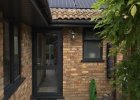23 Sep - 1 Oct 2022
Please get in touch at dorsetgreenerhomes@gmail.com if you would like to discuss our home or to come and visit
This event has now finished.
Just turn up Tours
Near Passive house withTimber frame
Sam and Sarah lived in an old mill house in the Bride valley, but felt that driving into Bridport two or three times a day was not sustainable, and decided to move into town. The Christian Science building had been vacant for 10 years, and they demolished it to build a house with two flats, which are rented out..
The building is made of structurally Insulated panels (SIPs) made of wood, and filled with sustainable wood fibre insulation (Pavaflex), with further wood fibre boards (Steico) on the outside. Part of the house is clad with Siberian Larch, the rest has a Baumit system lime render.The windows are triple glazed windows filled with inert gas. The house is near passivhaus standard, with an EPC efficiency rating of A (97).
This building is air-tight, with Mechanical Ventilation with Heat Recovery (MVHR) preheating the fresh air from the expelled stale air. The high level of insulation means little heating is required, but on very cold days
underfloor heating (UFH) and domestic hot water are heated by an Air Source Heat Pump (ASHP) on the roof. This extracts heat from the air outside. The house benefits from a Renewable Heat Incentive (RHI) for seven years to contribute to the price of the heat pump.
14 Photovoltaic (PV) solar panels produce up to 4.5lW, and charge up a 9.3 kWh battery on sunny days; any excess electricity is diverted to the Zappi electric car charger, to appliances and then to the grid. An export tariff of 15p per kWh is paid Solar thermal panels are also being considered for phase 2.
Sam and Sarah monitor their energy use and now have two years' worth of figures. Space heating last year took 1600 units of electricity, or £240 at last years rates.
...
Details of the construction of Sailcloth House (PDF, 299kB)
This event has now finished.

smaller.jpg)
.jpg)